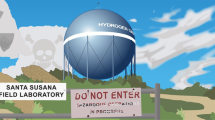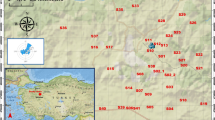Abstract
Nuclear and nonnuclear industrial and research activities have been conducted on the Hanford reservation since 1943. Materials originating from these activities may enter the surrounding environment through releases of airborne and liquid effluents and solid wastes. Concern about the environmental effects of these releases has evolved over the past four decades into a comprehensive onsite and offsite monitoring program. Today, environmental monitoring to assess potential impacts of released materials includes field sampling and chemical and physical analyses of air, ground and surface water, fish and wildlife, soil, vegetation, and foodstuffs. This paper reviews the history of Hanford operations and summarizes the current environmental monitoring program and its major findings. Mathematical models based on monitoring data show that radiation doses to people living near the Hanford site are well below existing regulatory standards. Only trace amounts of radionuclides from Hanford have been detected in the offsite environment.
Similar content being viewed by others
Literature cited
Beasley, T. M., L. A. Ball, J. E. Andrews III, and J. E. Halverson. 1981. Hanford-derived plutonium in Columbia River sediments.Science 214:913–915.
Becker, C. D. 1985. Anadromous salmonids of the Hanford Reach, Columbia River: 1984 status. PNL-5371, Pacific Northwest Laboratory, Richland, Washington. National Technical Information Service, Springfield, Virginia.
Cadwell, L. L., R. G. Schreckhise, and R. E. Fitzner. 1979. Cesium-137 in coots (Fulica americana) in Hanford waste ponds; contribution to population dose and offsite transport estimates. Pages 485–491in Proceedings, Health Physics Society, 12th midyear topical symposium on lowlevel radioactive waste management. Williamsburg, Virginia, February 11–15, 1979. EPA 520 (3-79-002), Environmental Protection Agency, Washington, DC.
Cushing, C. E., D. G. Watson, A. J. Scott, and J. M. Gurtisen. 1981. Decrease of radionuclides in Columbia River biota following closure of Hanford reactors.Health Physics 41:59–67.
DOE. 1981. Environmental protection, safety, and health protection program for DOE operations. DOE Order 5480.1 A. US Department of Energy, Washington, DC.
DOE. 1982. 316(a) Demonstration for test of N reactor in plutonium-only mode of operation. US Department of Energy, Richland, Washington.
DOE. 1983. Final environmental impact statement: operation of PUREX and uranium, oxide plant facilities. DOE/EIS-0089. US Department of Energy, Washington, DC.
DOE. 1986. Hanford environmental management program plan. US Department of Energy, Richland, Washington.
DOE. 1987. Plan and schedule to discontinue disposal of contaminated liquids into the soil column of the Hanford site. US Department of Energy, Richland, Washington.
EPA. 1976. National interim primary drinking water regulations. EPA-570/976-003. US Environmental Protection Agency, Washington, DC.
Freshley, M. D., and M. J. Graham. 1988. Estimation of ground-water travel time at the Hanford site. Description, past work, and future needs. PNL-6328, Pacific Northwest Laboratory, Richland, Washington. National Technical Information Service, Springfield, Virginia.
Gephart, R. E., R. C. Arnett, R. G. Baca, L. S. Leohart, and F. A. Spane Jr. 1979. Hydrologic studies within the Columbia Plateau, Washington: an integration of current knowledge. RHO-BWI-ST-5, Rockwell Hanford Operations, Richland, Washington. National Technical Information Service, Springfield, Virginia.
Graham, M. J., M. D. Hall, S. R. Strait, and W. R. Brown. 1981. Hydrology of the separations area. RHO-ST-42. Rockwell Hanford Operations, Richland, Washington.
Gray, R. H., and D. D. Dauble. 1977. Checklist and relative abundance of fish species from the Hanford Reach of the Columbia River.Northwest Science 51(3):208–215.
Gray, R. H., D. A. Neitzel, and T. L. Page. 1979. Water intake structures: engineering solutions to biological problems.The Northern Engineer 10(1):26–33.
Gray, R. H., T. L. Page, D. A. Neitzel, and D. D. Dauble. 1986. Assessing population effects from entrainment of fish at a large volume water intake.Environmental Science and Health A21(2): 191–209.
Haushild, W. L., G. R. Dempster, Jr., and H. H. Stevens, Jr. 1975. Distribution of radionuclides in the Columbia River streambed, Hanford Reservation to Longview, Washington. Geological Survey Prof. Paper, 433-0. US Government Printing Office, Washington, DC.
Klement, A. W., Jr., C. R. Miller, R. P. Minx, and B. Sleien. 1972. Estimates of ionizing radiation doses in the United States 1960–2000. ORP/CSD 72-1. US Environmental Protection Agency, Washington, DC.
McCormack, W. D., and J. M. V. Carlile. 1984. Investigation of ground-water seepage from the Hanford shoreline of the Columbia River. PNL-5289, Pacific Northwest Laboratory, Richland, Washington. National Technical Information Service, Springfield, Virginia.
Neitzel, D. A., T. L. Page, R. H. Gray, and D. D. Dauble. 1982. Once-through cooling on the Columbia River—the best available technology?Environmental Impact Assessment Review 3(1):43–58.
Nelson, J. L., and W. L. Haushild. 1970. Accumulation of radionuclides in bed sediments of the Columbia River between the Hanford Reach and McNary Dam.Water Resource Research 6:130–137.
Oakley, D. T. 1972. Natural radiation exposure in the United States. ORP/SID 72-1. US Environmental Protection Agency, Washington, DC.
Page, T. L., D. A. Neitzel, and R. H. Gray. 1977. Comparative fish impingement at two adjacent water intakes on the Mid-Columbia River. Pages 257–266in L. D. Jansen (ed.), Proceedings fourth national workshop on entrainment and impingement. Ecological Analysts. Melville, New York.
PNL. 1987. Environmental monitoring at Hanford for 1986. PNL-6120, Pacific Northwest Laboratory, Richland, Washington. National Technical Information Service, Springfield, Virginia.
Price, K. R. 1986. Environmental monitoring at Hanford for 1985. PNL-5817, Pacific Northwest Laboratory, Richland, Washington. National Technical Information Service, Springfield, Virginia.
Rickard, W. H., R. E. Fitzner, and C. E. Cushing. 1981. Biological colonization of an industrial pond: status after two decades.Environmental Conservation 8(3):241–247.
Rickard, W. H., W. C. Hanson, and R. E. Fitzner. 1982. The non-fisheries biotic resources of the Hanford Reach of the Columbia River.Northwest Science 56(1):62–76.
Rickard, W. H., and K. R. Price. 1984. Iodine in terrestrial wildlife on the US Department of Energy's Hanford site in southcentral Washington.Environmental Monitoring and Assessment 4(1984):379–388.
Rickard, W. H., and D. G. Watson. 1985. Four decades of environmental change and their influence upon native wildlife and fish on the mid-Columbia River, Washington, USA.Environmental Conservation 12(3):241–248.
Robertson, D. E., and J. J. Fix. 1977. Association of Hanford origin radionuclides with Columbia River sediment. BNWL-2305, Pacific Northwest Laboratory, Richland, Washington. National Technical Information Service, Springfield, Virginia.
Soldat, J. K., K. R. Price, and W. D. McCormack. 1986. Offsite radiation doses summarized from Hanford environmental monitoring reports for the years 1957–1984. PNL-5795, Pacific Northwest Laboratory, Richland, Washington. National Technical Information Service, Springfield, Virginia.
Sula, M. J. 1980. Radiological survey of exposed shorelines and islands of the Columbia River between Vernita and the Snake River confluence. PNL-3127, Pacific Northwest Laboratory, Richland, Washington. National Technical Information Service, Springfield, Virginia.
Swan, G. A., E. M. Dawley, R. D. Ledgerwood, W. T. Norman, W. F. Cobb, and D. T. Hartman. 1988. Distribution and relative abundance of deep-water redds for spawning fall chinook salmon at selected study sites in the Hanford Reach of the Columbia River, final report. National Marine Fisheries Service, National Oceanic and Atmospheric Administration, Seattle, Washington.
Tallman, A. M., K. R. Fecht, M. C. Marratt, and G. V. Last. 1979. Geology of the separations areas, Hanford site, southcentral Washington. RHO-ST-23. Rockwell Hanford Operations, Richland, Washington.
USGS. 1987. Subsurface transport of radionuclides in shallow deposits of the Hanford nuclear reservation, Washington—review of selected previous work and suggestions for further study. Open-File Report 87-222. US Department of the Interior, Reston, Virginia.
Vaughan, B. E., and W. H. Rickard. 1977. Hanford national environmental research park (NERP), a descriptive summary of the site and site-related research programs, 1952–1977. PNL-2299, Pacific Northwest Laboratory, Richland, Washington. National Technical Information Service, Springfield, Virginia.
WPPSS. 1978. Supplemental information on the Hanford generating WPPSS: project in support of a 316(a) demonstration. Washington Public Power Supply System, Richland, Washington.
WSDOE. 1977. Washington state water quality standards, chapter 173-201. Washington State Department of Ecology, Olympia, Washington.
Author information
Authors and Affiliations
Rights and permissions
About this article
Cite this article
Gray, R.H., Jaquish, R.E., Mitchell, P.J. et al. Environmental monitoring at Hanford, Washington, USA: A brief site history and summary of recent results. Environmental Management 13, 563–572 (1989). https://doi.org/10.1007/BF01874962
Issue Date:
DOI: https://doi.org/10.1007/BF01874962




